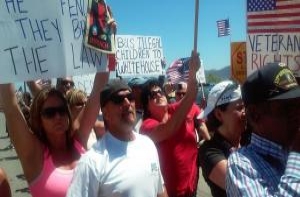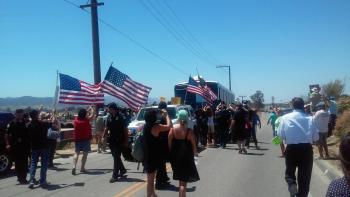
Hear our interview on the Central American immigrants: https://www.eastcountymagazine.org/sites/eastcountymagazine.org/files/au...
Updates on Murrietta, Congressman Juan Vargas' visit with immigrants in El Centro, and our interviews from this rally, including Enrique Morones of Border Angels. Rev. Beth Johnson from the Palomar Unitarian Universalist congregation and Everard Meade, Trans-Border Institute at USD, providing historical background on the Central American situation.
By Nadin Abbott
“What we need is humanitarian solutions. Sending the children back to sure death is not humanitarian.” – Enrique Morones, Border Angels
“This is a failure to enforce federal law at the federal level.” Murrieta Mayor Alan Long
July 2, 2014 (San Diego)—Yesterday, dozens of anti-immigrant protesters blocked buses carrying 140 immigrants from Central America, mostly women and children. Shouting racial slurs and carrying signs demanding the migrants be sent home, the protesters forced the buses bound for Murrieta to turn around and go to San Ysidro instead. The buses carried migrants from Texas, where holding cells are over flowing due to a massive influx of families and children.
Today, Border Angels held a rally in support of the immigrants and began a donation drive for toys, clothing, diapers to welcome the immigrants, most of whom were fleeing violence and threats of death in their homeland.
But what’s fueling the surge in immigration from Central America? To understand what’s happening today, we have to look back several decades into the history of the region and the role of U.S. foreign policy in Central America.
Supporters rally to help migrants
“What happened yesterday was disgusting. We will show the world that we love these children,” said Enrique Morones, Executive Director and Founder of the Border Angels, before the press conference. He also said that most of the people at both Escondido and Murrieta are not like the people who are afraid of these immigrants.
Organizations seeking to welcome the migrants including churches and immigration reform groups including the North County Immigration Task force, members of the Unitarian Church. LOFA from Escondido, the San Diego Dream Team, the Quakers of La Jolla, the Pilgrim United Church of Christ from Carlsbad, Casa Cornelia, the American Civil Liberties Task Force (ACLU) Immigration Taskforce, the MAC project, La Raza, and others.
According to Morones, “The most important people that are here are these children.” He added, “It is important that we love our children and that we treat our children with dignity and respect.”
Morones said he traveled to Murrieta yesterday, as an observer. “We saw the worst of the American spirit. These children simply want to live. These are migrants, these are refugees who are escaping a very violent situation in Central America. They simply want to live.”
Morones said Border Angels has already hosted a family who was turned over to them by the authorities, and kept them until relatives could be located; then the migrants were sent to join relatives. The woman was from Guatemala with her two children, ages 4 and 9 years old. They had crossed from Guatemala. Border Angels housed them for a couple of days and then ensured safe passage across the country. “They went home to the only home that they know in the United States, where their father is,” said Morones.
Like all immigrants in similar circumstances they need to report to Immigration and Customs Enforcement (ICE) near their new address within 15 days.
Morones said that Border Angels has received calls and emails from all over the country, as far away as Hawaii, offering homes for the immigrants.
The principles driving the Angels are “Love has no borders. But we need to live that, not only in words but in actions.”
USD border expert discusses historic roots of the crisis
Everard Meade, Director of the Trans-Border Institute at the University of San Diego (photo, left) told the crowd that he is troubled, since in the debate over immigration, people tend to operate “with different sets of facts.” Thus “when we are faced with a crisis, we are faced with immediate polarization.” He urged the media and crowd to be skeptical of claims made and to “exercise good judgment.”
He pointed out that the protest yesterday was not large, yet drew national media attention -- much of it focused on negative messages on signs. Ira Mehlman with the Federation for American Immigraiton Reform, which is listed as a hate group by the Southern Poverty Law Center, told City News Service that he believes many of the immigrants are criminal gang members; he blames the influx on the Obama administration’s Deferred Action for Childhood Arrivals.
But Meade counters, “We need to show a little bit of basic empathy.” He added that we all can agree there is a crisis on the southern border, but that no good policy solutions will come “if we panic.” He warned people not to assume that the worst assumptions are facts.
 For example, anti-immigration protesters have denounced the immigrants as criminals, when in fact, many faced death threats from criminal gangs themselves. How many of us would become lawbreakers by crossing a border if your only other option was death, rape or violence against yourself or your family members, or being forced to join a criminal gang to avoid being murdered?
For example, anti-immigration protesters have denounced the immigrants as criminals, when in fact, many faced death threats from criminal gangs themselves. How many of us would become lawbreakers by crossing a border if your only other option was death, rape or violence against yourself or your family members, or being forced to join a criminal gang to avoid being murdered?
Asked what he believes the real reasons are fueling the influx of Central American immigrants, Meade replied, “There is a very clear connection between U.S. intervention in the region generally during the second half of the cold war.” That said, he noted, this is “bigger than one particular policy.”
For example, the Reagan administration funded death squads backed by the governments in El Salvador and Guatemala, including genocide in Guatemala, keeping right-wing governments in power to prevent leftists from taking over.
It is important to understand that the children are nearly all coming from El Salvador, Honduras and Guatemala, which had different levels of U.S. intervention during the 1970s and ‘80s, particularly during the Iran-Contra period, Meade noted. During the height of that crisis, the U.S. also denied refugee status. Therefore a “huge proportion of the Central American population in the United States is people who asked for refugee status during the wars and didn’t get it.” He said that some stayed undocumented, some were deported and some received amnesty in the 1980s.
Then during the ‘90s, America largely forgot about Central America, not sending significant foreign aid or other support. The void has filled with social conditions such as poverty and most significantly, organized crime that did not exist before. The murder rate, is now worse than it was at the height of the civil war. Then the war on drugs moved south as well.
Thus American foreign policy contributed to the conditions that are now a crisis. The U.S. has adopted a piecemeal means of addressing crisis after crisis a comprehensive approach.
The US has also been deeply involved in migration policy, training and funding national immigration officers in these countries. This is part of trying to stop the flow of immigration, but it has not worked, Meade indicated.
Perhaps most shocking, he observed, “The worst human rights violations committed against kids are committed by law enforcement officers in those countries, or people who operate with their tacit agreement.”
Another factor has been Central American Free Trade Agreement (CAFTA) has also contributed to the economic problems fueling migration from rural agricultural areas to cities, and ultimately other countries because the local agricultural economies have collapsed under an influx of cheap agricultural products from the U.S. and elsewhere. The legacy of this failed policy is that today, remittances, or funds send home by people who have left these countries, is now 17-20% of the economies there.
As far as Guatemala, half of the kids coming from Guatemala are indigenous Maya Indians. They are suffering violence and extreme poverty. The reason many don’t have parents goes back to the administration of Rios Mott, president of Guatemala in the 1980s who was recently convicted of ordering massacres and committing genocide against thousands of Maya Indians.
Many of today’s refugees turning up at our borders lost their own parents in the massacre of Maya Indians a generation ago. Now adults, they continue living in poverty and some have become victims of violence themselves, along with their children.
The causes for this crisis are multiple and complex. Thus simplistic solutions such as sending all immigrants home to situations where many could be slaughtered, fail to take into account the potential moral obligation to address the legacy of failed U.S. policies in Central America.
 Regardless of past history, one point is clear today: U.S. detention facilities for immigrants are over-strained, with more migrants entering then we have room to hold under humane conditions. Immigration opponents have raised concerns over the impacts of such a large influx on schools, jobs, and public health. The U.S. is not the only destination; Cental American refugees are also fleeing to Canada and other nations.
Regardless of past history, one point is clear today: U.S. detention facilities for immigrants are over-strained, with more migrants entering then we have room to hold under humane conditions. Immigration opponents have raised concerns over the impacts of such a large influx on schools, jobs, and public health. The U.S. is not the only destination; Cental American refugees are also fleeing to Canada and other nations.
Is blocking buses really the answer to the tide of humanity fleeing dangerous conditions? If not, what then, is the solution?
Short term, one potential option could be to establish refugee camps in Central America and have U.S. embassies there accept refugee status applications and have the United Nations assist in finding safe havens for those who qualify – distributing refugees among multiple nations to avoid a massive surge into any one country, such as the spike in Central American refugees currently being seen in the U.S.
Long term, changing trade policies and understanding the consequences of globalization, as well as rethinking intervention based on political grounds could help to stabilize these economies, reduce violence, poverty and the tide of immigrants in Central America.
Nadin Abbott has a masters degree in Mexican History from San Diego State University.







Recent comments